Sharks: Part 1
Issue date: 29th September 2020
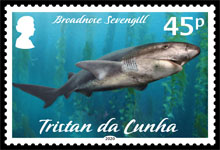 |
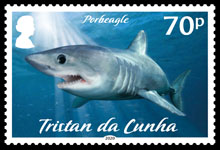 |
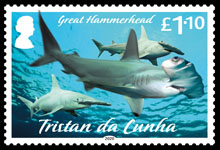 |
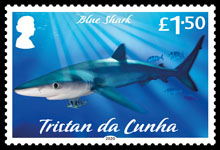 |
| 202007 | Mint Stamps (45p, 70p, £1.10, £1.50) | £3.75 |
| 202008 | First Day Cover (with 45p, 70p, £1.10, £1.50 stamps) | £4.75 |
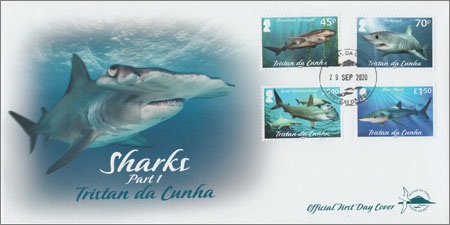
Description
45p - Broadnose Sevengill Shark (Notorynchus cepedianus)
The Broadnose Sevengill shark is an 'ancient' shark, the only existing member of the genus Notorynchus, in the family Hexanchidae. It lives in relatively shallow, temperate seas worldwide, except the North Atlantic and Tristan is one of the few mid-ocean archipelagos where it is known to occur. It is recognisable by its seven gill slits, while most shark species have only five. It grows up to 2.5m (8ft) long and is pale grey with a white belly. These are the most common sharks found inshore at Tristan, where its local name is 'Rock Shark', and they feed mainly on fish, octopus and squid, but also on general carrion. The species is not well studied and is listed as 'data deficient' by the IUCN red list.
70p - Porbeagle (Lamna nasus)
The Porbeagle is a species of mackerel shark in the family Lamnidae, and is a smaller relative of the Great White Shark. It is distributed widely in the cold and temperate marine waters of the North Atlantic and Southern Hemisphere. In 2017, the National Geographic Pristine Seas Expedition recorded a single pup at approximately 60cm (2ft) long. This was the first observation for the species, in Tristan waters, and suggests it was likely born here. It is possible that Porbeagle sharks use the islands as a nursery area so the islands may have significant importance to these species of shark. The Porbeagle is listed as Vulnerable globally, mainly due to overfishing.
£1.10 - Great Hammerhead (Sphyrna mokarran)
The Great Hammerhead inhabits tropical waters around the world, between 40°N and 37°S. It is the largest species of hammerhead shark, belonging to the family Sphyrnidae, attaining a maximum length of 6m (20ft). The Great Hammerhead can be distinguished from other hammerheads by the shape of its 'hammer' (called the 'cephalofoil'), which is wide with an almost straight front margin, and by its tall, sickle-shaped first dorsal fin. The Great Hammerhead feeds on a wide variety of prey ranging from crustaceans and cephalopods, to bony fish and smaller sharks. Females bear litters of up to 55 pups every two years. Great Hammerheads move into the Tristan area during the warmer summer months, but do not reach Gough, where the water temperature is 3-4 degrees colder. It is listed as Critically Endangered, mainly due to overfishing.
£1.50 - Blue Shark (Prionace glauca)
Blue Sharks are one of the great ocean wanderers. These slim, graceful sharks, up to 2.5m (8ft) long with large eyes and brilliant blue backs are known to make journeys of up to 9,200 km (5,700 miles) with some individuals making multiple trans-Atlantic crossings. Research suggests that the waters of Tristan da Cunha may provide a refuge for these gentle giants. Both large females and small juveniles occur, suggesting that the waters around Tristan da Cunha are a blue shark nursery ground with large females traveling here to give birth. The lack of intense fishing effort seen in other parts of the world hopefully provides a sanctuary for the pups to grow in peace before undertaking migrations of their own. Despite occurring through most of the world's oceans, their numbers are decreasing due to fishing pressure, and the species is listed as near-threatened globally.
FDC - Great Hammerhead (Sphyrna mokarran)
Technical Specifications from Pobjoy Mint Ltd.
| Designer: | Andrew Robinson | ||
| Printer: | bpost | Stamp size: | 42.02 x 27.66mm |
| Process: | Lithography | Perforation: | 11½ per 2cms |
| Production Co-ordination: | Creative Direction (Worldwide) Ltd | Sheet format: | 10 |
